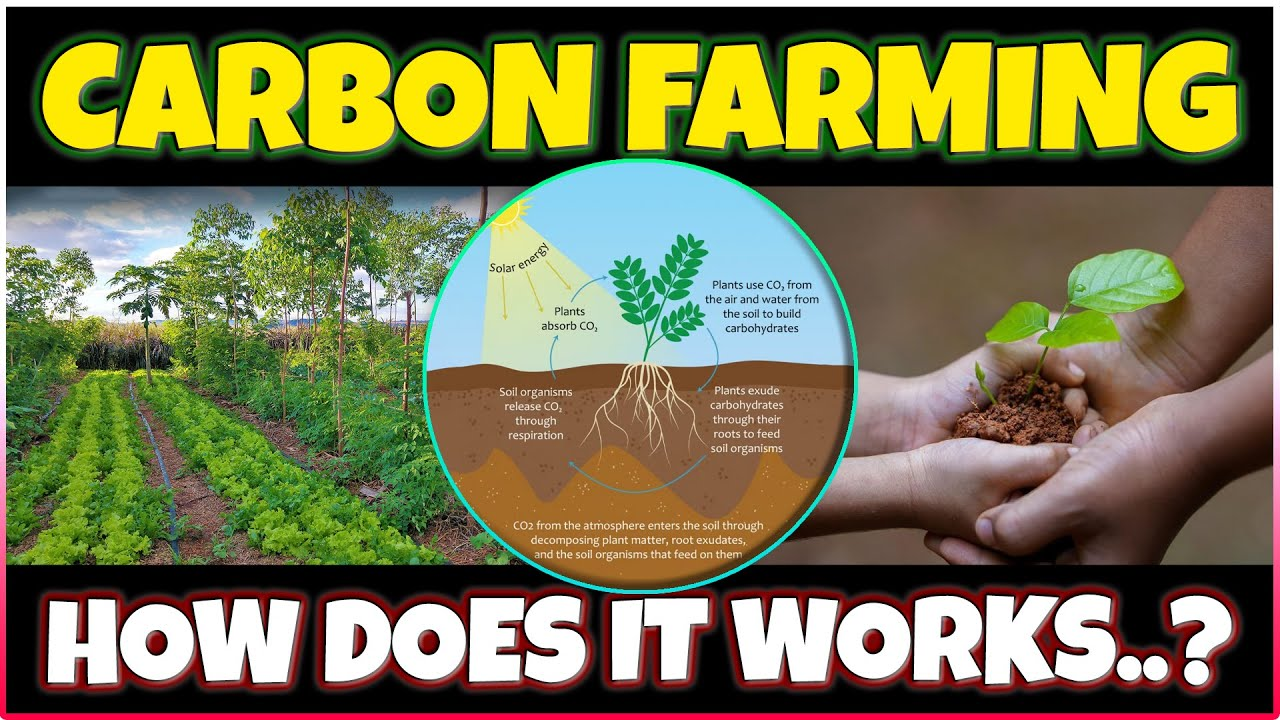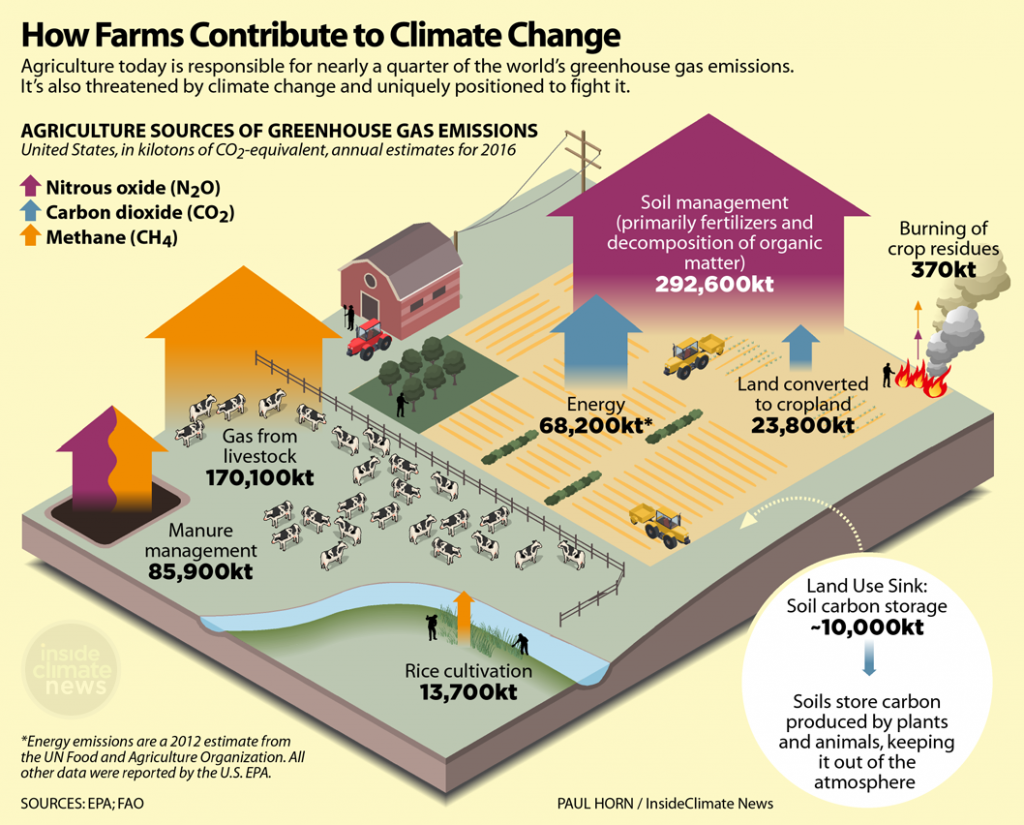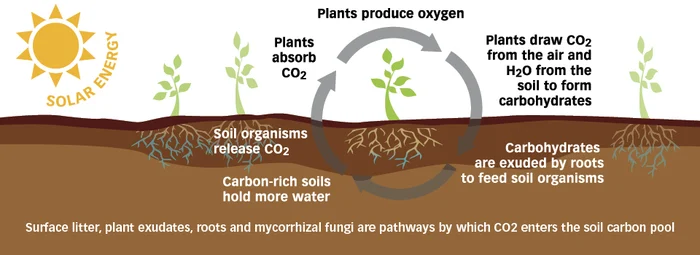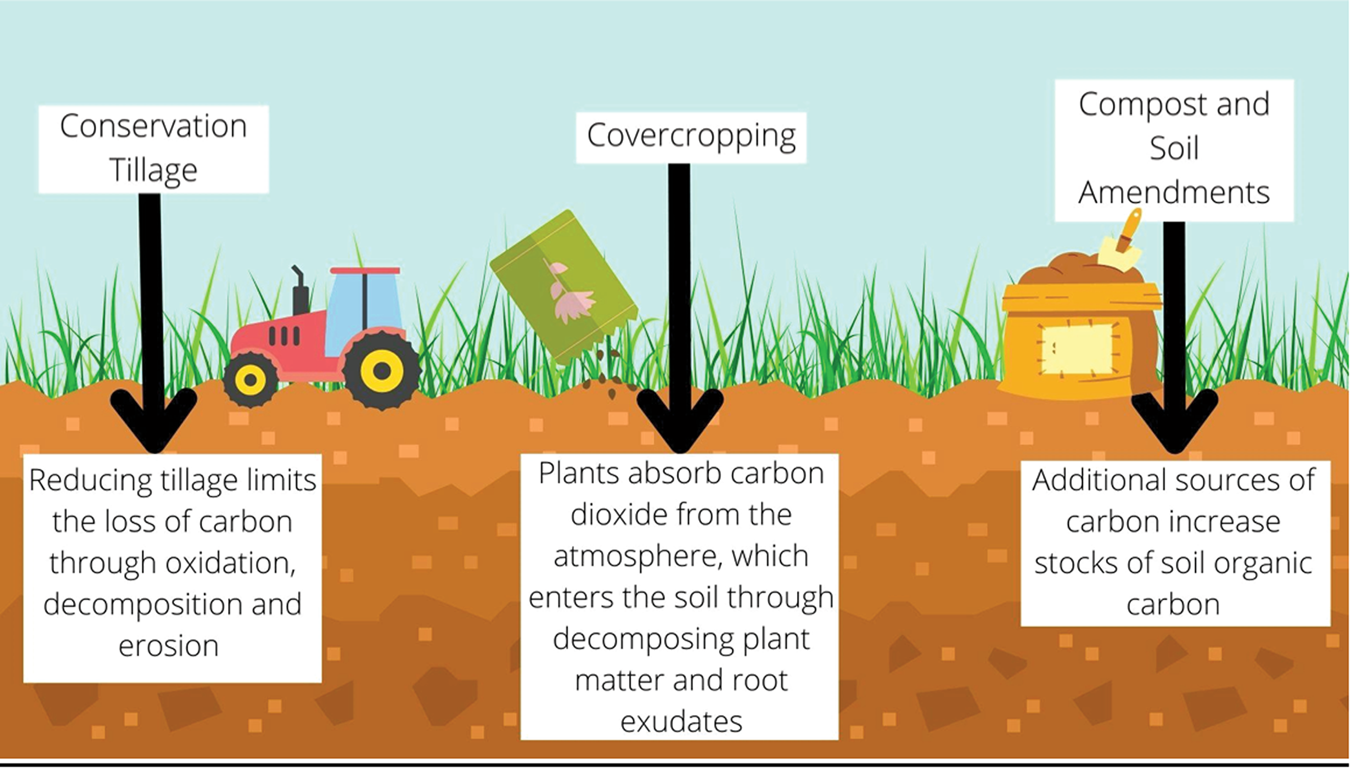
Copyright infringement not intended
Picture Courtesy: https://www.youtube.com/watch?v=Vc_wBYKXqKs
Context: Carbon farming transforming agriculture by employing climate-smart practices to increase soil health, store carbon, and reduce greenhouse gas emissions, resulting in a more sustainable food system.
About Carbon farming
- Carbon farming refers to a set of agricultural practices aimed at mitigating climate change by increasing carbon sequestration in soils and vegetation while reducing greenhouse gas emissions associated with agricultural activities.
- This approach involves implementing regenerative agricultural techniques that enhance soil health, promote biodiversity, and contribute to sustainable land management.
|
Carbon farming involves a set of agricultural methods focused on storing carbon in soil, crop roots, wood, and leaves through a process called carbon sequestration. The primary goal is to reduce the net amount of carbon dioxide (CO2) in the atmosphere by increasing carbon storage in agricultural landscapes. It holds immense potential as a key strategy for climate change mitigation and sustainable agriculture.
|

Significance of Carbon farming
- Mitigating Climate Change: By storing carbon in the soil and reducing greenhouse gas emissions, carbon farming can significantly contribute to combating climate change.
- Improving Soil Health: Healthy soil improves water retention, reduces erosion, and increases the availability of nutrients for plants. This leads to improved crop yields and overall agricultural productivity.
- Enhancing Biodiversity: Carbon farming practices often promote biodiversity by creating more complex ecosystems within agricultural landscapes. This attracts beneficial insects and pollinators, which can further improve crop health and reduce reliance on pesticides.
- Creating Economic Opportunities: Carbon farming practices can create new income streams for farmers through carbon credit markets and potentially higher yields from healthier soil.

Techniques within Carbon Farming to Reduce Greenhouse Gas Emissions
Rotational Grazing
- This approach involves moving livestock to fresh pastures on a regular basis. This helps the previously grazed area to recover, reducing erosion and encouraging healthy regrowth. Healthy vegetation, in turn, absorbs CO2 from the environment and stores it in the soil via photosynthesis.
Agroforestry
- Integrating trees and bushes into crop fields offers various advantages. Trees operate as natural carbon sinks, storing large volumes of CO2 as they develop. In addition, their shade helps manage soil temperature and moisture, and their leaves can be used to compost organic materials. Shrubs can also help by providing more habitats for beneficial insects and pollinators.
Conservation Agriculture
- This method reduces soil disturbance by employing strategies such as no-till farming, which involves planting crops straight into existing residue from the previous season. This improves soil structure, encourages the growth of beneficial bacteria, and increases organic matter content.
- Organic matter is essential for carbon storage, and healthy soil with high organic matter content is more fertile and productive.
Integrated Nutrient Management
- This strategy emphasizes using organic fertilizers and compost instead of synthetic fertilizers. Organic matter decomposition releases nutrients slowly over time, promoting healthy plant growth and reducing the risk of nutrient leaching into waterways. Additionally, organic fertilizers often contribute to increased soil organic matter content, further enhancing carbon storage.
Agro-ecological Practices
- This broad category includes techniques that promote biodiversity and mimic natural ecosystems within agricultural landscapes.
- Practices like crop diversification and intercropping (planting multiple crops together) create a more resilient system. This can help reduce pest outbreaks and disease pressures, potentially leading to a decrease in reliance on synthetic pesticides. Diverse plant communities can improve soil health and contribute to increased carbon sequestration.
Improved Livestock Management
- Strategies like optimizing feed quality for animals can lead to reduced enteric fermentation – a digestive process that produces methane, a potent greenhouse gas. Additionally, proper management of animal waste can prevent methane emissions from manure decomposition.

Challenges in Implementing Carbon Farming, Particularly in Developing Countries like India:
- Location Dependence: The effectiveness of different carbon farming techniques can vary significantly depending on factors like geographical location, soil type, climate, and water availability. Practices that work well in regions with plentiful rainfall might not be suitable for drier areas.
- Water Scarcity: Practices like cover cropping, which involve planting additional vegetation between main crop cycles, can increase water demand. This can be a challenge in regions where water is already scarce and prioritized for drinking and washing needs.
- Financial Constraints: Implementing new carbon farming methods can involve initial costs for things like equipment or seeds. This can be a barrier for small-scale farmers with limited financial resources.
- Policy and Awareness: Lack of supportive government policies and limited farmer education on carbon farming practices can hinder widespread adoption.
Global Initiatives in Carbon Farming
- Carbon Trading: Voluntary carbon markets are emerging in some countries like the U.S., Australia, New Zealand, and Canada, allowing farmers to earn additional income for verified carbon sequestration activities. This can incentivize the adoption of carbon farming practices.
- Global Initiatives: Initiatives like the '4 per 1000' initiative, Kenya’s Agricultural Carbon Project (supported by the World Bank), and the Carbon Farming Initiative in Australia promote carbon farming globally.
|
Studies suggest that agroecological practices in India could generate significant economic benefits for farmers. Additionally, regions with extensive agricultural land have the potential to benefit greatly from carbon farming practices.
|
Opportunities for Carbon Farming in India
- Climate Resilience: Climate-resilient agricultural practices can benefit from adaptation strategies, especially in regions like the Indo-Gangetic plains and the Deccan Plateau.
- Economic Benefits: Agro-ecological practices in India could generate significant economic value and income for farmers through sustainable agriculture.
- Policy and Awareness: Scaling up carbon farming in India requires increased policy support, technological advancements, and awareness among farmers about the benefits and techniques of carbon farming.
Way Forward
- Continued research is crucial to develop location-specific carbon farming techniques that are optimized for different agro-climatic conditions.
- Providing financial assistance to farmers, particularly small-scale farmers, can help overcome the initial cost barrier associated with adopting new practices.
- Government policies that incentivize carbon farming practices and reward farmers for carbon sequestration can significantly promote its adoption.
- Educating farmers about the benefits of carbon farming and providing training on implementing these practices is essential for widespread adoption.
- As consumers become more aware of the environmental impact of food production, there could be an increased demand for products grown using carbon farming practices. This could incentivize farmers to adopt these methods.
- Technological advancements in areas like precision agriculture and soil monitoring can further enhance the effectiveness of carbon farming practices.
- Collaboration between farmers, researchers, policymakers, and consumers is essential to develop and implement successful carbon farming initiatives.
Conclusion
- Carbon farming holds immense potential as a climate change mitigation strategy, offering multiple co-benefits such as improved soil health, biodiversity conservation, and economic opportunities for farmers. To realize these benefits, comprehensive support from governments, international organizations, and research institutions is essential to overcome challenges and promote the widespread adoption of sustainable agricultural practices.
Must Read Articles:
Framework For Voluntary Carbon Market In Agriculture Sector And Accreditation Protocol Of Agroforestry Nurseries
Source:
The Hindu
Wikipedia
|
PRACTICE QUESTION
Q. Large-scale implementation of carbon farming could lead to land-use changes or competition for resources like water. How to ensure that carbon farming practices are implemented ethically and equitably, considering the needs of small-scale farmers, local communities, and potential social impacts?
|







